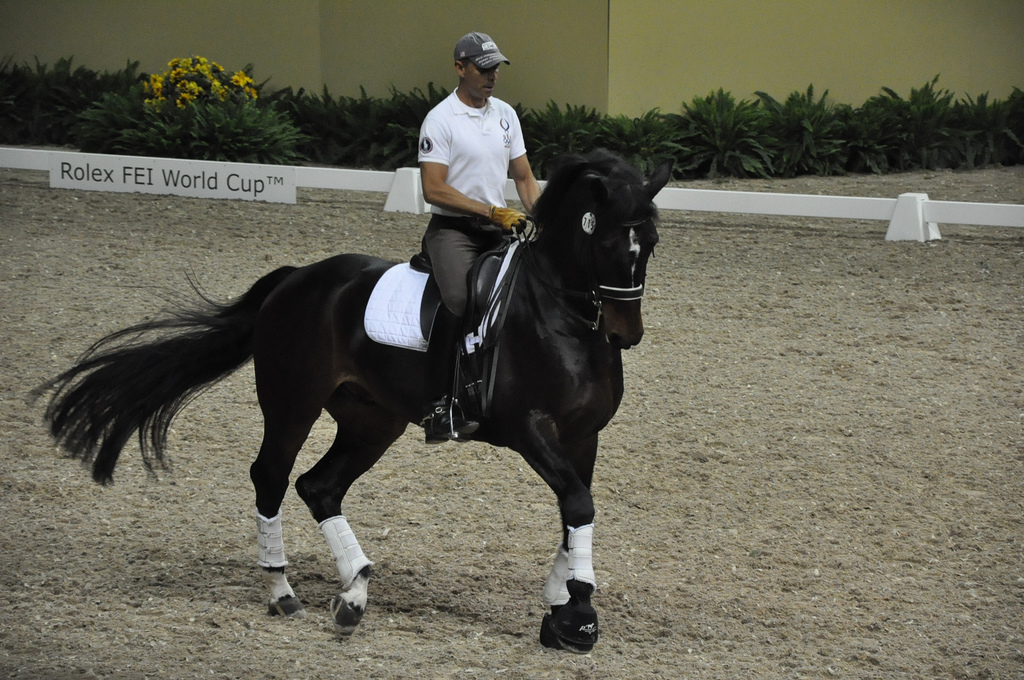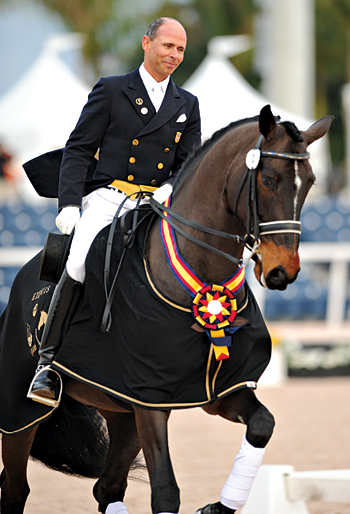 Steffen Peters and Ravel
Steffen Peters and Ravel
In my ongoing somatic research into the art and sport of riding, I have been watching Bonnie Bainbridge Cohen’s videos on the endocrine glands. I have had bi-lateral hip replacements, and prior to that was in pretty significant, limiting pain for about twenty years. As a result. I am always curious about the relationship of my body – in contact with the horse primarily through my hips – and the horse’s body.
Even with my beautiful new porcelain/titanium hips, I could feel that the old holding patterns resulting from that pain were there, and that I could never seem to fully unravel them. Over the past year, I have been strongly drawn to re-investigate Body-Mind Centering, the brilliant, transformative work of Bonnie Bainbridge Cohen. In the videos, Bonnie goes through the glands starting at the root, with the coccygeal body, the perineal body, then the gonads and the adrenals. She demonstrates how tucking the pelvis, or attempting to straighten the back by curling the tail under, closes off and deadens the coccygeal body and the perineal body and those chakra centers. I can often feel that in my riding (or sitting at the computer) I am doing a subtle version of that in a mistaken, habitual effort to protect my lower back.
Instead, in the rising trot, think of an action somewhat like the fluid pumping of the jellyfish: feel a narrowing of the pelvic quadrants as you rise and a widening of the space between sitz bones and coccyx/pubis as you sit. Soften down each time in a supported way as you sit. Engaging the gonadal line (ovaries or vas deferans) creates an energetic relationship between the head and the feet – a kind of bow and arrow countertension. So as you rise in the trot, ascend through the head and descend through the feet with an elastic feeling. Visualize the adrenals adding power and support to both actions.
In my ride yesterday, I consciously integrated all of those actions with my lovely, patient horse Sanne. The result was astonishing. His trot had a buoyant, floating energized feeling that I have never fully felt before. I realized that unconsciously, I had been holding my hips, still in that slightly braced, protective position, even as I tried to loosen and open them. Working from the glands, moved me away from the musculo-skeletal focus into a more energetically amplified relationship with myself and my horse. The other thing that I found helpful was to feel how each pelvic half is actually a part of the leg, with the sacrum – a part of the spine – floating between. This gave me a greater feeling of both balance and freedom in the walk, the trot and the canter. Applying the jellyfish and the bow and arrow actions in the canter was amazing – I truly felt that I had joined up in my horse’s movement – more air than earth!
I chose the photos above of rider Steffen Peters because I saw in them something I rarely see so clearly and consistently expressed in riders – a beautiful energetic alignment – as if the chakras are all open, illuminated, engaged. The second photograph perfectly captures the “bow and arrow” feeling in the rising trot – a breautiful relationship between earth and sky!
As I write this, I am reminded of Linda Tellington-Jones’s words during a workshop. Whenever she would encounter a “problem” with a horse, whether physical or behavioral, she would say, “Isn’t that interesting?” Those words invoke a sense of curiosity, play and improvisation. Opening to possibility rather than contracting around a difficulty. The same has to be true of ourselves. It would be too easy to become frustrated or impatient with my own limitations as a rider. Maintaining an attitude of willingness, curiosity and playfulness is my goal for each ride, each rehearsal, each day.
